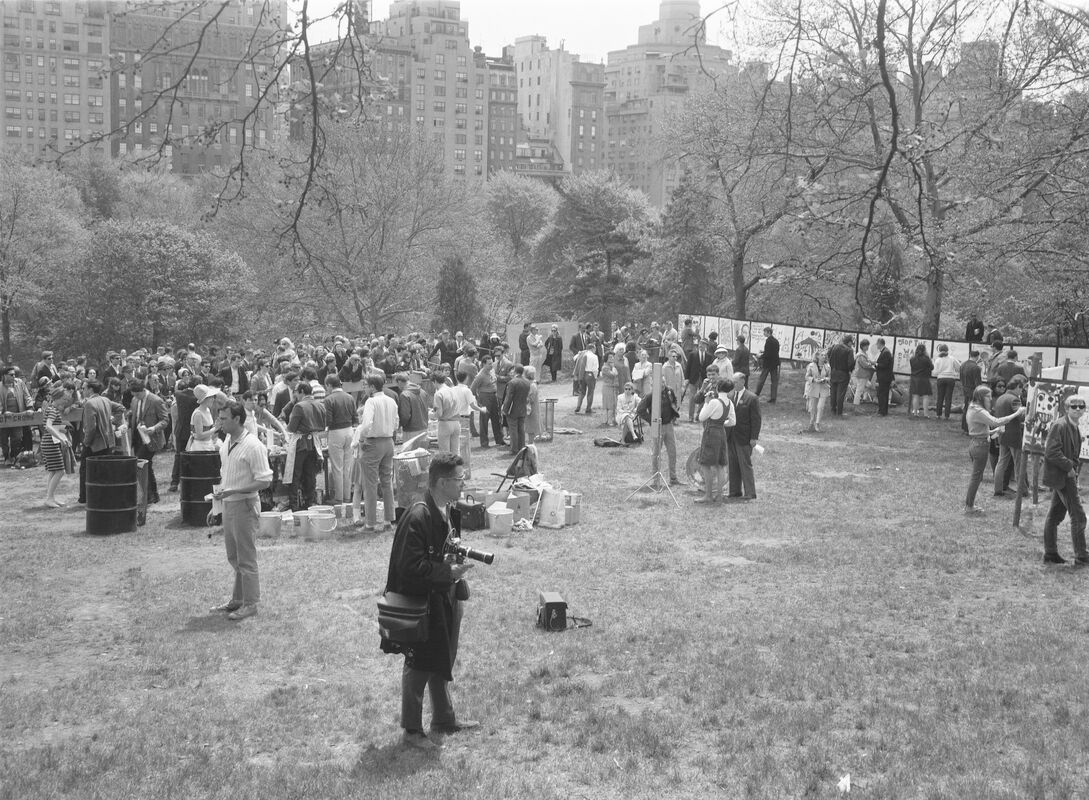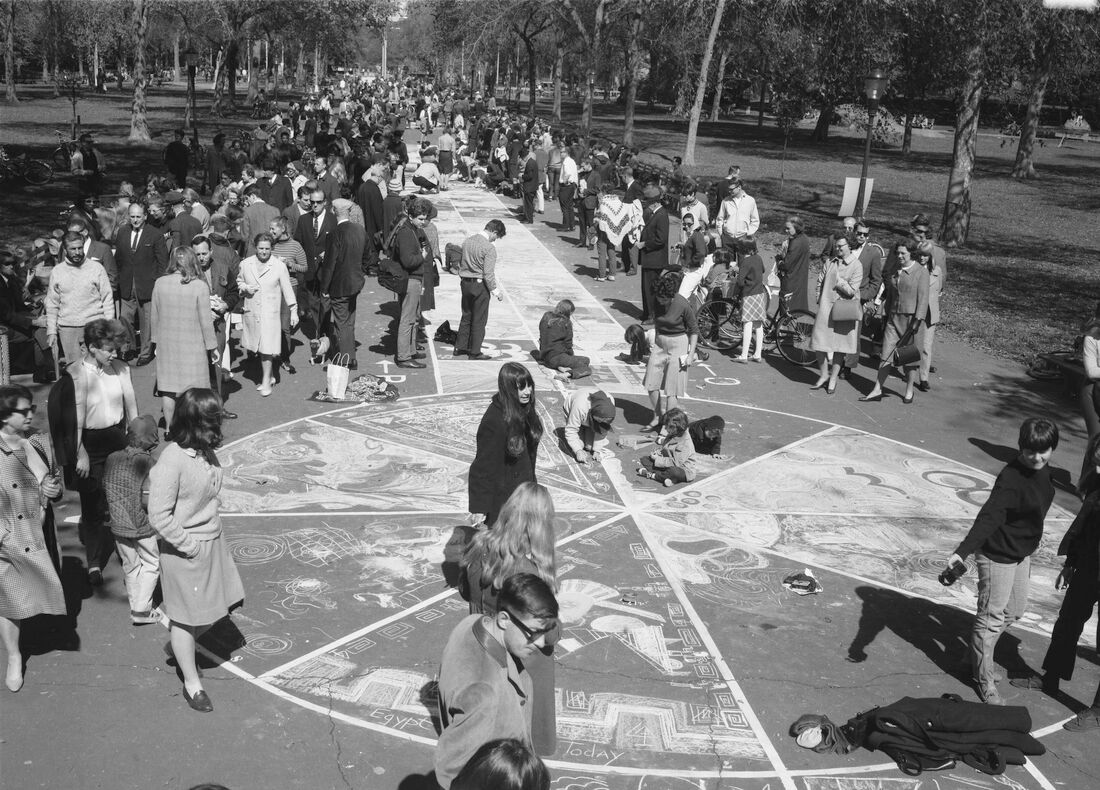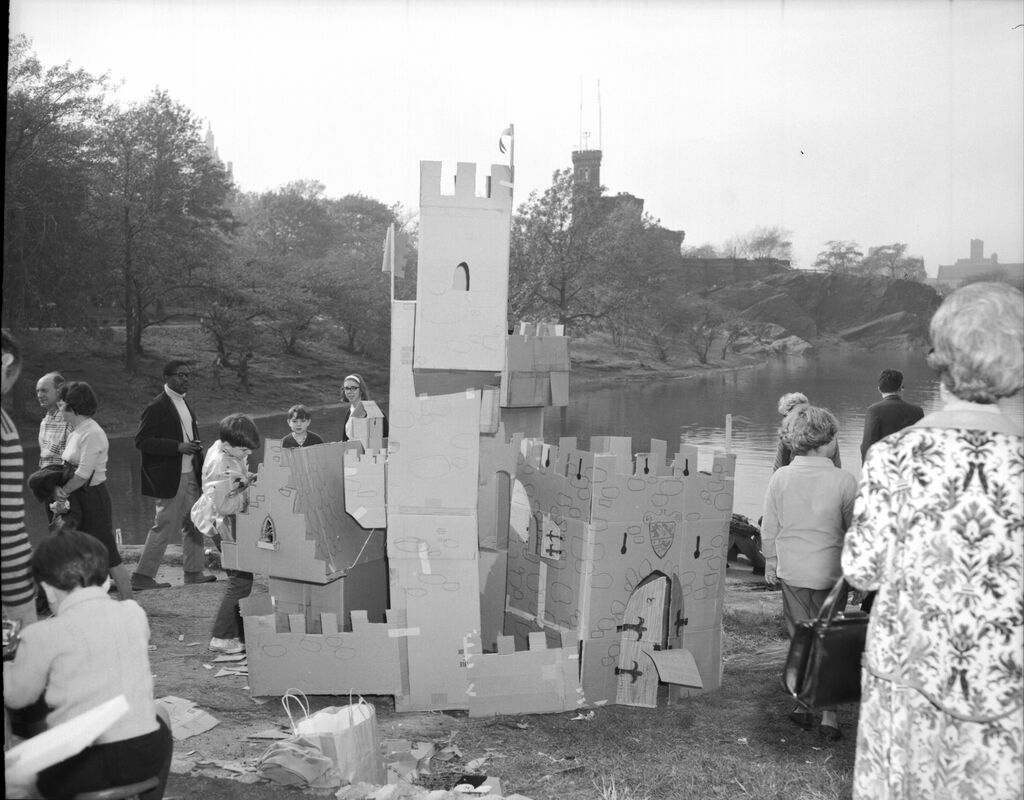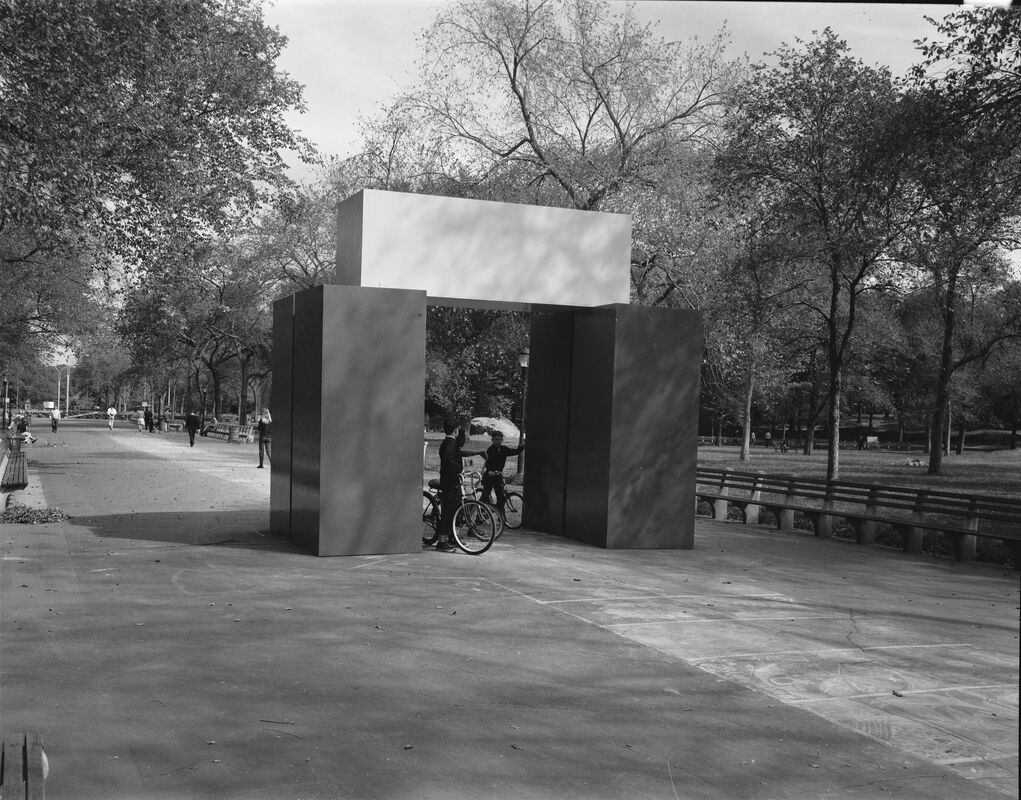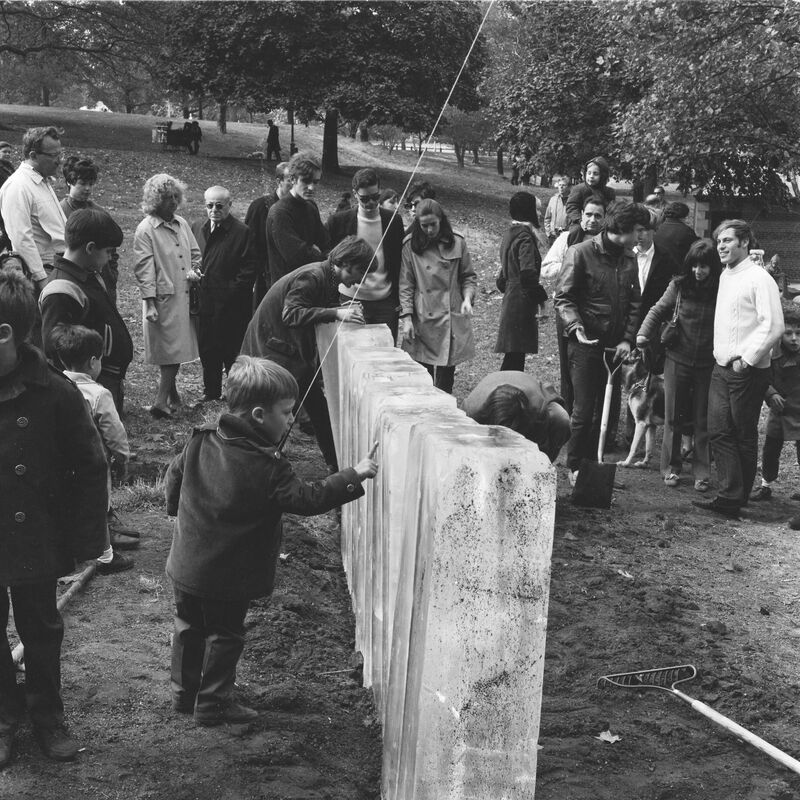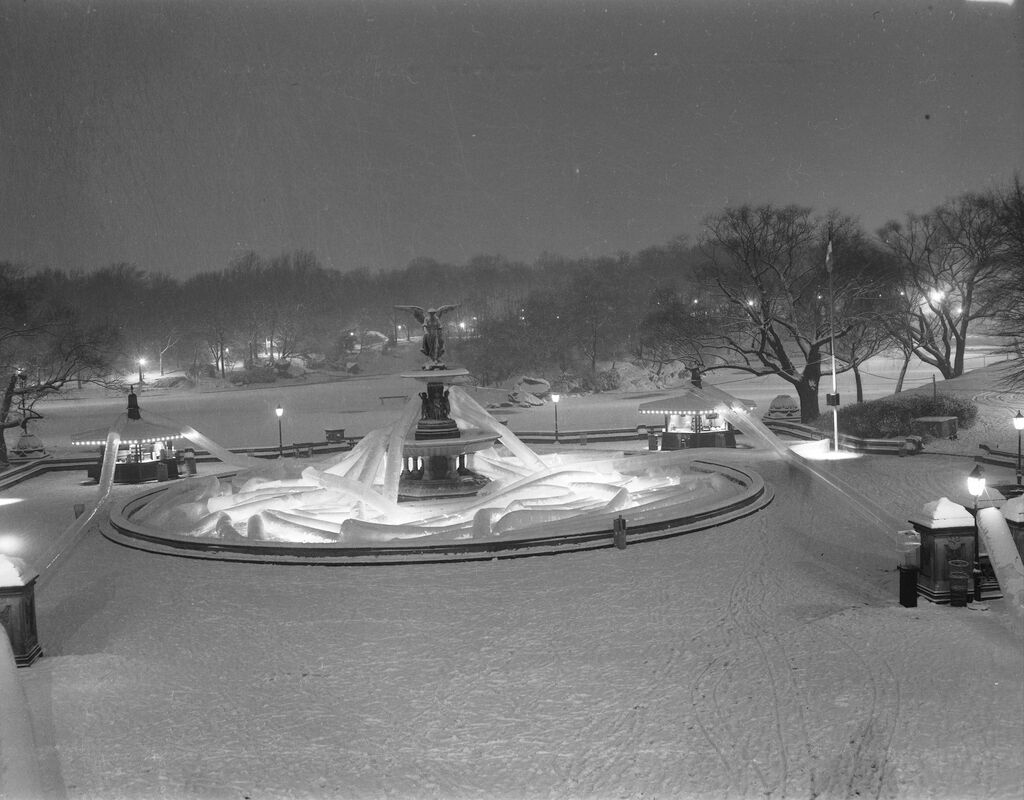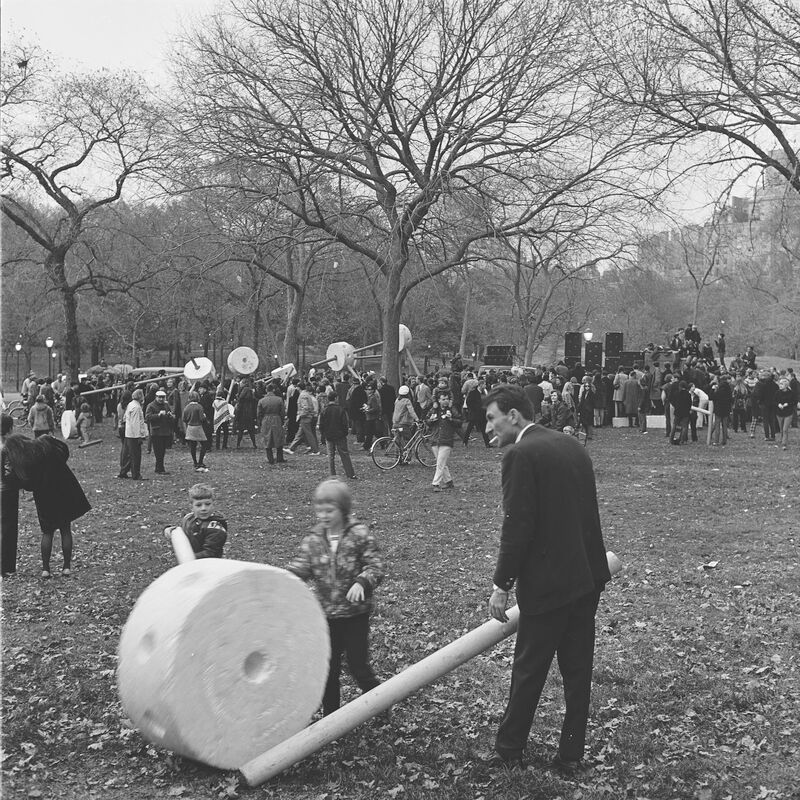Happenings: Art, Play, and Urban Revitalization in 1960s Central Park
By Marie Warsh
On November 16, 1966, an unprecedented event took place on the Sheep Meadow in Central Park. Beginning at midnight, thousands of New Yorkers convened on the park’s largest lawn to watch the Leonid meteor showers, which were expected to be particularly brilliant. Although the crowd was let down — dense cloud cover prevented visibility — the gathering nonetheless offered a convivial atmosphere. Spectators brought chairs, blankets, and hot beverages, and the event became an after-dark picnic, with some marveling at the novel scene. One woman observed, “All these people in the park after midnight, and no one is getting mugged.”[1]
New York’s Parks Commissioner, Thomas Hoving, had conceived of the event, which he’d dubbed the “Heavenly Happening,” and it epitomized his approach to revitalizing Central Park. The event was a direct response to concerns about safety in the park. Incidents of crime began to increase in the late 1950s, and this reality, as well as often ominous or even sensationalized press coverage, contributed to a growing reputation of the Central Park as a “hoodlum haven,” as J. Edgar Hoover declared in 1964.[2]
Cartoon Performance, May 15, 1966. The first happening in Central Park involved the installation of a 105-foot-long canvas across the lawn known as Cedar Hill for the public to paint on. Capturing the open-ended nature of the happening, the press release for the event stated that “The performance will end when the painting is finished, or when it rains, or when it grows too dark to continue.”
Impressions of Central Park as unsafe reflected more widespread concerns about public spaces, which by the early 1960s were suffering from neglect and deterioration and becoming prominent signs of cities in decline. According to a 1962 survey of New Yorkers by the Park Association (a longstanding parks-advocacy organization), people most frequently associated parks with fear.[3] New York Mayor John Lindsay, who campaigned on improving the public realm, promised increased surveillance and police presence in parks. He enlisted Hoving, previously a curator at the Metropolitan Museum of Art, to address these issues.[4] In response, Hoving envisioned public programs like concerts, festivals, and art installations to draw New Yorkers back into Central Park and other parks that they had been avoiding.
By calling this meteor shower celebration a “happening,” Hoving also conveyed his desire to cultivate new forms of park experience. The event was part of a series of events in Central Park called happenings that Hoving and subsequent park administrators hoped would provide more than just a feeling of safety in the crowd, but a deeper engagement in public space and community. The Parks Department organized kite-flying (previously banned in the park), other events such as stargazing, a massive game of capture the flag, and various participatory art programs. Despite the wide range of events given the name “happening,” reflecting the popularization of the word and idea, they were still connected to the origins of the term as an avant-garde art form.
The artist Allan Kaprow initially used the word “happening” during the late 1950s to describe experimental performances that dismantled the longstanding relationship among artist, spectator, and setting defined by the experience of art objects in the space of a gallery or museum. Kaprow’s happenings, which took place in a variety of sites, many of them outdoors, involved a set of instructions or guidelines enacted by spectators or other participants, ideally resulting in chance incidents or spontaneous actions. Kaprow compared the happening to a game and promoted an ideal of art as play. He furthermore emphasized that play should not be limited to children. This approach permeated the Parks Department’s programs, many of which were even organized by, or involved, contemporary artists well-versed in Kaprow’s ideas.[5] Soon after taking office, Hoving hired Phyllis Yampolsky, an experimental artist affiliated with the Judson Memorial Church, as the “artist-in-residence” for the Parks Department. Yampolsky organized many of the happenings, which she also called “experimental public games.”[6] During this period, Central Park was also the setting for several significant art festivals and exhibitions of public art. One of the most notable, the Fourth Avant-Garde Festival, included more than one-hundred works in a variety of media, an unprecedented presentation of experimental art in a public setting. The musician and performance artist Charlotte Moorman organized the festival and stated that she was interested in reaching a broader audience than was possible in previous years when it was staged indoors, and, furthermore, in “not making art such a snobbish, mysterious thing,” a goal of inclusiveness that corresponded to the city’s efforts to increase access to the arts.[7]
The Park’s Department’s openness specifically to avant-garde art and culture, part of what historian Michele Bogart has called “municipal counterculture,” was central to its program of revitalization of parks such as Central Park and presenting them as hip, fun, and democratic.[8]
Photographs of these events in the New York City Parks Photo Archive show park-goers painting, building, and playing, as well as spectating and socializing—they capture the hybrid nature of these events as sources of individual creative exploration, community gatherings, and performances. Details on these events are found in the Parks Department’s press releases, which point to how publicity played an important role in generating excitement.[9] The photographs also show Central Park. While some of these events were intended to engage the park’s landscapes and features in new ways, for most of them, the park functioned primarily as a stage, and it gets somewhat lost in the background as a result.
As time has passed, fewer people are aware of how this proliferation of events, and their lack of management, contributed to the severe deterioration of Central Park. One of the last major events of the 1960s was focused on another celestial phenomenon: a massive gathering on the Sheep Meadow to watch the television coverage of the Apollo 11 moon landing on the night of July 20, 1969. The event captured the fusion of art and popular culture that defined this period in Central Park’s history, but also marked the beginning of a transition. Called the “Moon Watch” or “Moon-In,” it was an elaborate event.[10] Celebrating this historic feat were a variety of celestially inspired artworks (a synthetic aurora borealis), themed food (frozen Milky Way bars, blue cheese), a taped lecture by Buckminster Fuller regarding the moon and the future, and lots of music and dancing. But most of the photographs in the NYC Parks Photo Archive document not the event, but its aftermath—the extraordinary mess left on the Sheep Meadow. The photographs point to the next chapter in this story, back on earth, when both park administrators and New Yorkers began to try to figure out how to clean up after the party.
The Day After the Moon-In, July 21, 1969. The five-thousand spectators who gathered to watch footage of the moon landing and participate in other celebratory events were not deterred by heavy rains, but the event and the weather left the Sheep Meadow trashed and eroded.
Marie Warsh is the historian for the Central Park Conservancy. Her book, Central Park's Adventure-Style Playgrounds: Renewal of a Midcentury Legacy, is forthcoming from Louisiana State University Press in the fall of 2019.
All photos courtesy of the New York City Parks Photo Archive.
Notes
[1] Terence Smith, “Asia Sees Meteors; Show Here Foiled,” New York Times, November 17, 1966.
[2] John Sibley, “Hoover Draws Angry Response for Comment on Central Park,” New York Times, November 20, 1964.
[3] Park Association, “Citizens View Their Parks,” December 1962. Parks Council Records, Avery Architectural & Fine Arts Library, Columbia University.
[4] Parks and Recreation, campaign white paper issued by John Lindsay (New York, 1965).
[5] Kaprow described the happening as “A game, an adventure, a number of activities engaged in by participants for the sake of playing.” Quoted in Eva Meyer-Hermann, Andrew Perchuk, and Stephanie Rosenthal, eds., Alan Kaprow: Art as Life(Los Angeles: Getty Research Institute, 2008), 68.
[6]“Events in Open Air,” Department of Parks Press Release #107, August 1, 1966.
[7] Joan Rothfuss, Topless Cellist: The Improbable Life of Charlotte Moorman(Cambridge, MA: MIT Press, 2014), 211.
[8] Michele H. Bogart, Sculpture in Gotham: Art and Urban Renewal in New York City(London: Reaktion Books, 2018): 42.
[9] These are available online: https://www.nycgovparks.org/news/reports/archive#pr (accessed November 8, 2018).
[10]“The Man on the Moon Will Have an Audience in Central Park Meadow,” Department of Parks Press Release #860, July 11, 1969.
